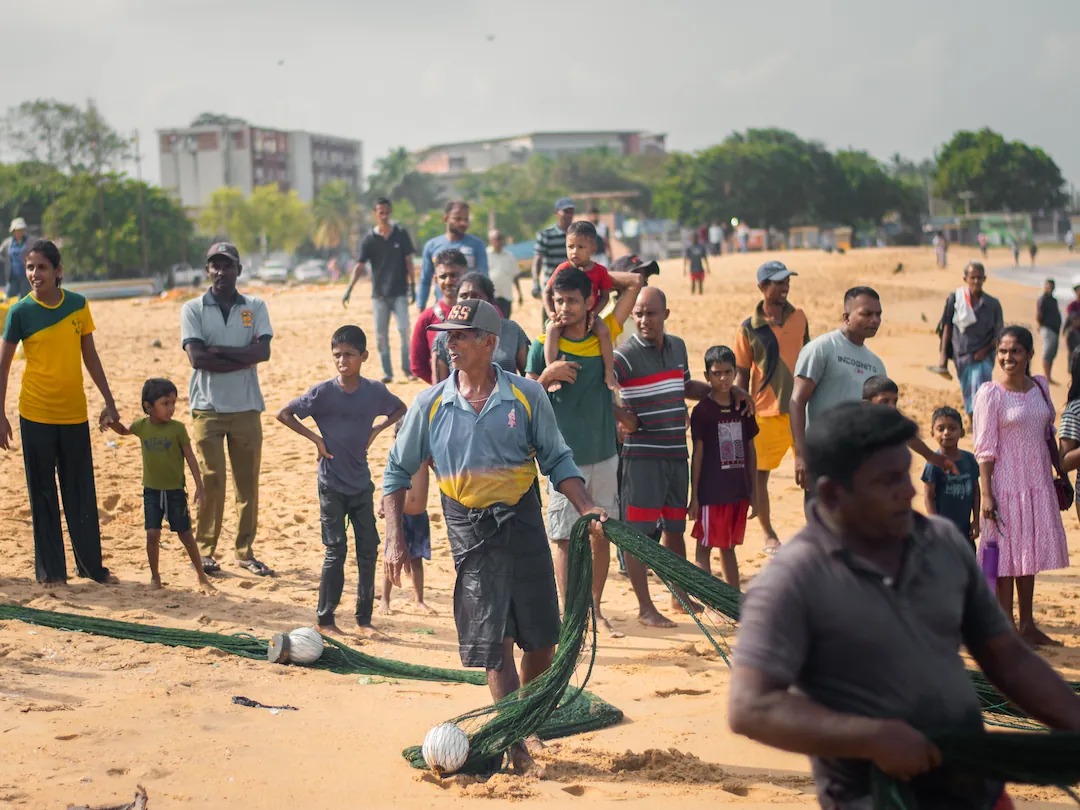Negombo is a very charming coastal town and a tourist attraction in Sri Lanka. Just 9 kilometers or, let’s say, 20 minutes from Bandaranaike International Airport. Within that 20 minutes, you’ll even forget there was a city called Colombo.
Negombo is that beautiful. If you wanna get more information about traveling to Negombo, we have you covered from our previous article, “The Ultimate Transportation Guide to Negombo.”
Negombo is known for its sandy beaches and rich fishing heritage, and hey, super tasty food, too.
Negombo wasn’t always known for its sandy beaches and bustling resorts. Long before it became a popular getaway for travelers and tourists, it was—and still is—a fishing town at heart. Fishing has been the backbone of Negombo’s economy for generations, providing a livelihood for many local families.
Walking through the market, you can feel that history in every corner. So, personally, I call myself a wanderer. I don’t plan tours, mostly. I love to cycle through Negombo, but when I’m here, I always wonder how many stories this beach can tell about how the lively hood of Sri Lankan culture expands.
Take a minute and think about it. The local life here still circles around the ocean, just as it did centuries ago. Locals head out before dawn, casting their nets with the same skill passed down through the generations.
It’s a town where fishing isn’t just a job. It’s a way of life. It’s basically who they are, and that is what their culture bonded around.
Negombo Fishing roots
Negombo’s fishing origins run deep, going back hundreds of years. Long before modern boats and fancy equipment, the locals relied on their own hands and handmade tools to pull fish from the ocean. Fishing has been a part of this town’s heartbeat for as long as anyone can remember. Generations have passed down their knowledge and skills, teaching the young how to navigate the waters and understand the rhythms of the sea.
Interestingly, when the Portuguese and Dutch colonized Sri Lanka, they left their mark on the fishing trade in Negombo.
The Portuguese introduced new methods and equipment, which the local fishermen adapted into their routines. Later, the Dutch stepped in, setting up trade routes and using Negombo as a base for the cinnamon trade, but they also tapped into the rich fishing culture here.
Although foreign powers came and went, the spirit of fishing stayed strong among the people of Negombo. It became not just a means of survival but a proud tradition, holding the community together through times of change.
Today, if you wander along the beaches or visit the local markets, you can still see some of those old methods in action. If you want to know more about that experience, you can read it in our “Ultimate 2024 Guide to the Negombo Fish Market, Sri Lanka” article.
Traditional Fishing Practices & Modern Challenges

Photo by Sandaru Muthuwadige
In Negombo, traditional fishing is almost an art passed down through generations. One of the first things you’ll notice is the boats known as Oruwa and Maadel. These boats have a unique design and are built with balance and simplicity.
The Oruwa is an elegant outrigger canoe that cuts through the waves effortlessly. At the same time, the Maadel is used for a larger, cooperative style of fishing where groups of fishermen pull in huge nets.
Watching the locals handle these boats and nets, you can’t help but feel a deep respect for the skill it takes to navigate the sea using just the wind, the waves, and raw human strength.
Fishing in Negombo is about more than just catching as many fish as possible. Many of the locals still rely on their hands, traditional nets, and simple tools, sticking to methods their ancestors used. There’s a way and almost a rhythm to it – the timing of the tides, the movement of the fish, and even the cooperation of fellow fishermen.
It’s a community effort, and everyone has a role. From the elderly men who repair the nets to the younger fishermen out on the water, it’s all about teamwork. When they bring in the catch, the whole village gathers to share in the reward, splitting up the fish and preparing it for sale or for the family table.
But things are changing, and not always for the better. Modern technology has crept into the fishing scene in Negombo. Bigger boats, advanced equipment, and even motorized trawlers have shifted how things are done. On one hand, it’s made fishing faster and more efficient. On the other hand, it has brought some serious problems.
Overfishing is now a real concern, as these larger operations can take more than their fair share, leaving less for the small-scale fishermen who rely on the sea for their daily survival.
The competition with bigger industries, combined with environmental changes like rising sea temperatures and unpredictable weather patterns, has made it tough for local fishermen to thrive like they once did.
Despite these challenges, the fishing community remains resilient. They adapt where they can, but the pull between tradition and modern pressures is something they face every day.
Cultural Significance & Festivals
In Negombo, fishing is deeply woven into the cultural and spiritual fabric of the community. One of the most striking examples of this connection is the way fishing and religion go hand in hand. St. Anne’s Feast, for instance, is a grand celebration that brings the entire fishing community together.
Every year, the fishermen and their families gather to honor St. Anne, the patron saint of fishermen. They pray for blessings, calm seas, and a plentiful catch, trusting that their hard work will be rewarded through divine protection.
The festival is a lively, colorful affair that feels like a mix of tradition, faith, and joy. Boats are decorated, and religious processions fill the streets as the community gives thanks for the ocean’s bounty.
You’ll often see fishermen attending mass with candles in hand, asking for safe journeys, and praying for their loved ones.
Aside from the grand St. Anne’s Feast, the community also commemorates their livelihood in small, everyday rituals. Before embarking at dawn, many fishermen will offer a brief prayer, sprinkle blessed water over their boats, or simply gaze out to sea in a moment of quiet contemplation.
Sustainability Efforts By The Negombo Fishing Community
Sustainability has become a big deal in Negombo, especially with the pressure the fishing industry is under. The local community, which has relied on the ocean for generations, knows that if they don’t take care of their waters, there might not be much left for future generations.
That’s why many fishermen have started shifting toward more sustainable practices. Instead of focusing on how much they can catch, they’re more mindful about what they’re catching and when. They follow seasonal fishing patterns, giving certain fish species a chance to breed and replenish.
On top of that, there’s a growing interest in eco-tourism. Tourists who want more than just a quick visit to the fish market are getting involved in responsible fishing tours. These tours offer an inside look at how the locals fish sustainably, often using smaller boats and traditional techniques that don’t harm the environment.
It’s a hands-on way for visitors to understand the challenges the fishermen face while also appreciating the beauty of the ocean in a way that’s respectful and educational.
These experiences provide tourists with something unique and help spread awareness about why protecting the ocean is crucial for Negombo’s fishing community.
In some instances, visitors can even partake in ‘catch-and-release’ tours, where they fish with the locals but release the catch back into the sea. This allows them to experience the thrill of fishing without harming the ecosystem.
